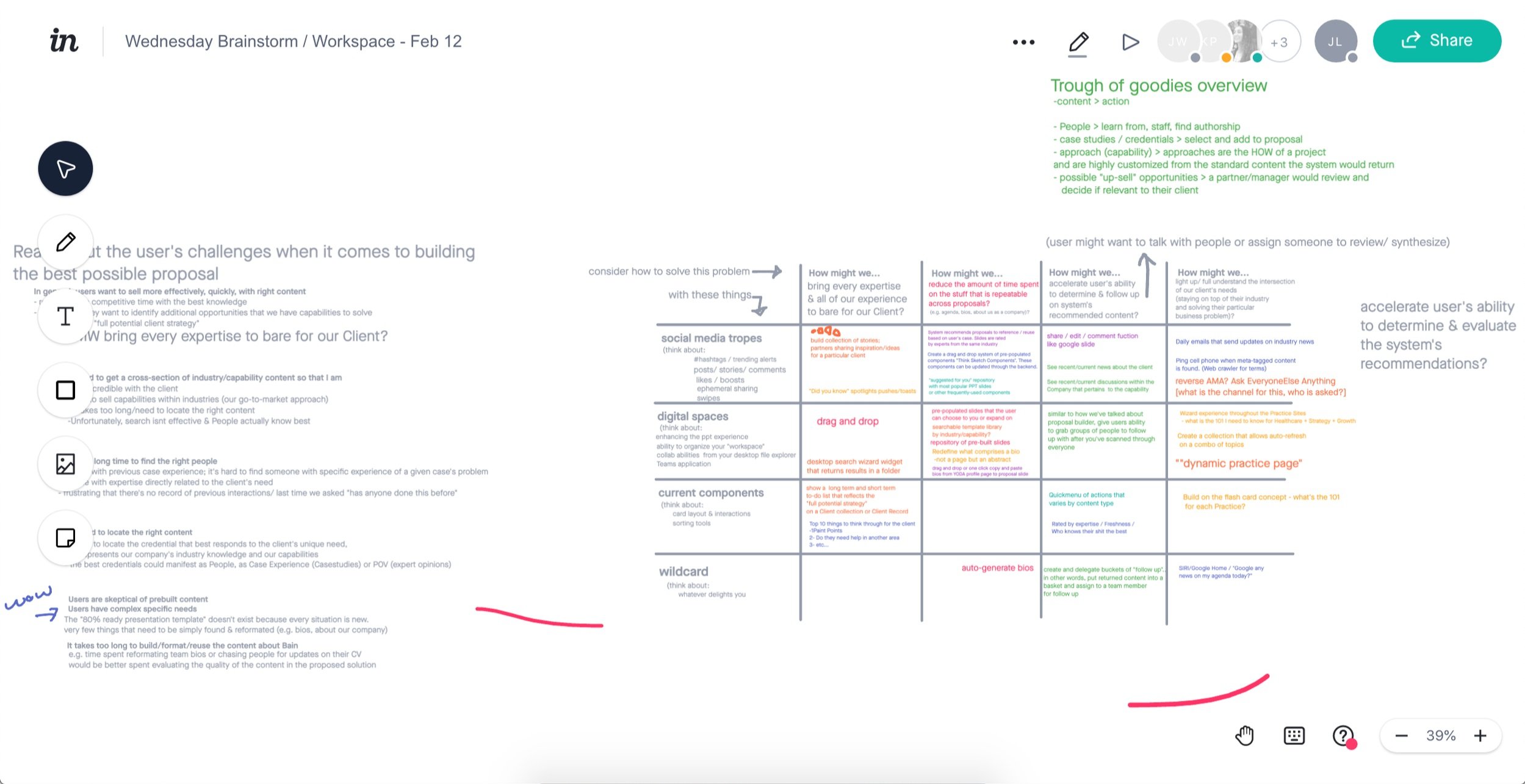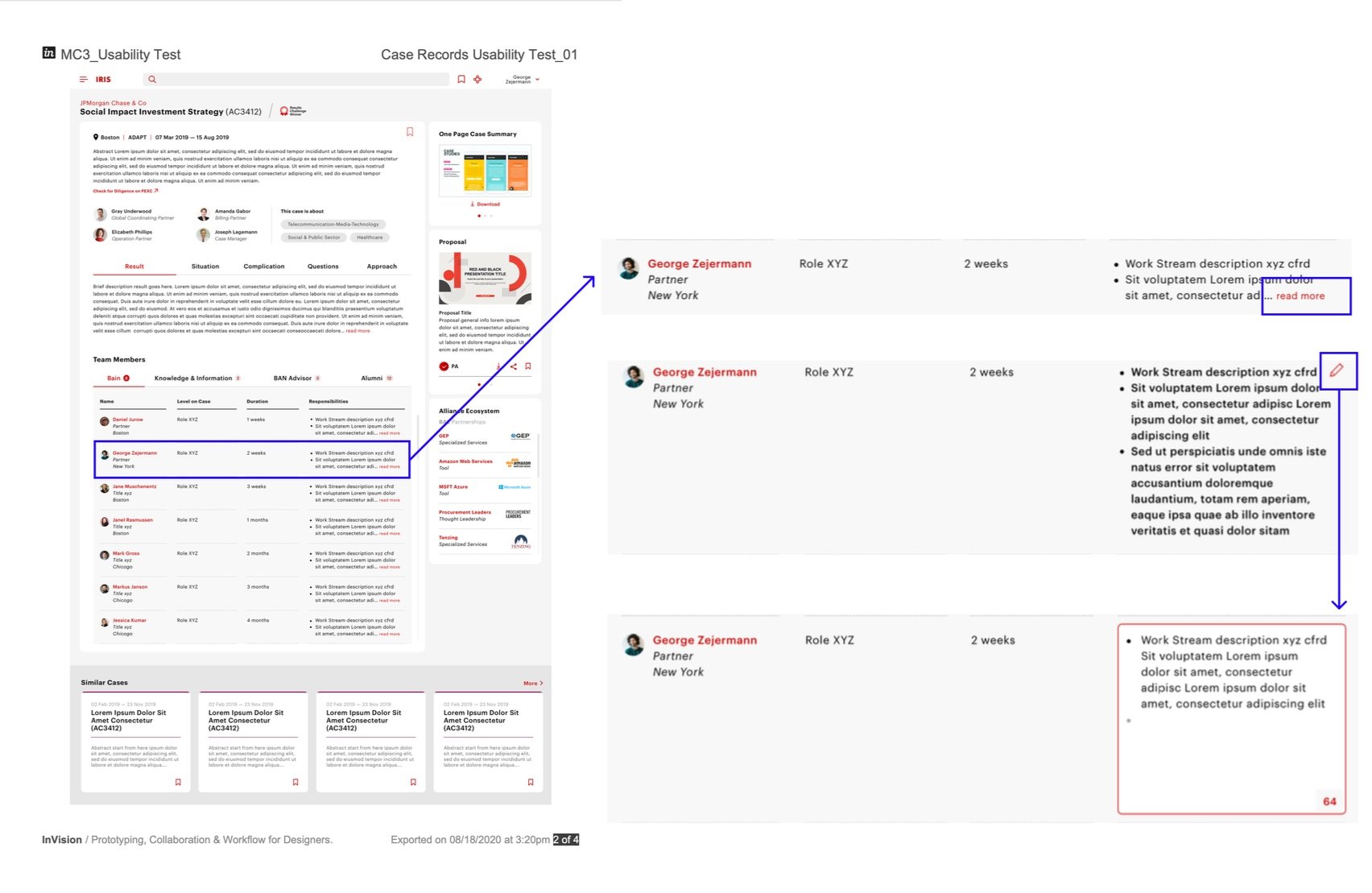
Bain& CompanyKnowledge Management System
Bain & Company requested Avanade to rebuild their knowledge management system used by 15,000 employees globally.
In this case study, I have excluded and disguised sensitive information. The content presented here represents my personal work and does not necessarily represent the opinions or perspectives of Bain & Company.
The Challenge
One of the top concerns cited by users was the amount of time they spent looking for information within the system. Their original platform relied on manual and inefficient means to collect, categorize, and publish knowledge. High-cost resources spent many hours wading through the system only to doubt the final results. This cost the firm time and money and created frustration for their employees.
My Role
As one of two UX designers, I validated existing pain points and user needs and gathered insights by interviewing users and stakeholders. Then, we used research insights to define detailed features and functionalities and translated them into wireframe visualizations. When product development sprints kicked off, the UX team partnered with product managers to communicate between the product team (Avanade) and POs (our clients), overseeing the product development process.
User Interview
The UX team interviewed 10 users and learned about their pain points with the original knowledge platform.
The Breakdown of the Original Knowledge Platform
The original knowledge platform had a simplistic structure that struggled to efficiently accommodate a vast amount of data.
The original knowledge platform structure
List of all the business verticles and related content types
Key Insights
Based on user’s feedback, we developed five key insights that will form the foundation of Iris.
Prioritize the most relevant content
Being personal, proactive & predictive
Dismantling the current content black market
Content components have greater value than documents
No dead-ends
Before the pandemic, the Avanade team, comprising two UX designers, a tech lead, a FED lead, and two project managers, traveled every week to Bain's headquarters in Boston to collaborate in person with the five product owners. When the global pandemic struck midway through our project, we leveraged online tools such as InVision and Mural. These tools allowed us to maintain design thinking workshops and conduct quick brainstorming sessions, enabling continued collaborative work during feature defining phase.
The UX team went through multiple iterations of wireframes and conducted usability tests before and after the visual design phase.
Wireframe Examples
The primary focus of the search experience was to identify the optimal filtering system and determine the layout for arranging content blocks.
Usability Test Example
I created a clickable prototype to test a 'read more' feature that expands the content block and reveals the content edit icon. Some product team members expressed concerns that the edit icon might not be prominent enough, potentially causing users to overlook it. However, the result showed that the expanding interaction triggered by clicking 'read more' was sufficient to draw the user's attention to the edit icon.
Search Experience
We ensured there were threaded experiences throughout the new knowledge platform, Iris– no more “what do I do now?” moments. Every screen of Iris provided anticipated pathways and recommendations on the most relevant next step, whether generating proposals, researching topics, or finding experts.
The search experience was the foundation of Iris to provide a seamless threaded experience. By incorporating dynamic search, self-tagging, and auto-tagging, the accuracy of finding the right content increased by 50%.
The code name MC3 was used instead of 'Bain' on design mock-ups to adhere to NDA requirements during the design phase.



Workspace
Iris is crucial in helping Bain secure new business by streamlining the proposal creation process. The previous workflow relied heavily on phone calls and chat, with PowerPoint decks exchanged via email, leaving room for efficiency improvement.
To address this, we introduced Workspace as a key Iris feature. Workspace offers intelligent slide and client data recommendations from Bain's internal content library, simplifies team management, enables real-time collaboration, and seamlessly integrates existing content into proposals. This holistic approach reduced proposal creation time by 20%.
Create New Workspace
From the Iris landing page, users can create a new workspace. With Smart Tags, Workspace collects data to give the team a head start in realizing the client's full potential.
Best of Bain
The Best of Bain feature organizes all pre-collected data based on common questions the team must address when starting a case. Users can update the Smart Tags anytime to retrieve more personalized results.
Proposal Builder
By integrating slides from similar cases as templates, Proposal Builder ensures that the case team can access the best available resources. Users can effortlessly import their saved slides or explore the offerings of their teammates, all from a single location.
Content Viewer
Users can now view documents within Iris using the Content Viewer. They can conveniently save important slides to 'My Slides' and share them with the rest of the case team by sending them to the Proposal Builder. This eliminates the need to search through email threads or manually copy and paste slides between different PowerPoint files.
Takeaways
Successfully redesigning a complex infrastructure with a large amount of disorganized information requires full transparency within the team, as unexpected requirements could arise during the development phase and cause delays and confusion.
To speed up the decision-making process, the UX team involved the development team leads from the early stages of defining features to ensure each feature's feasibility and usability before presenting it to the client (POs). This helped establish trust between the Avanade team and the client during the wireframing phase, reducing the need for excessive communication and revisions during the development phase.
Since the soft launch of the search experience in 2021, Iris has increased work efficiency dramatically, beloved by Bain employees worldwide.













